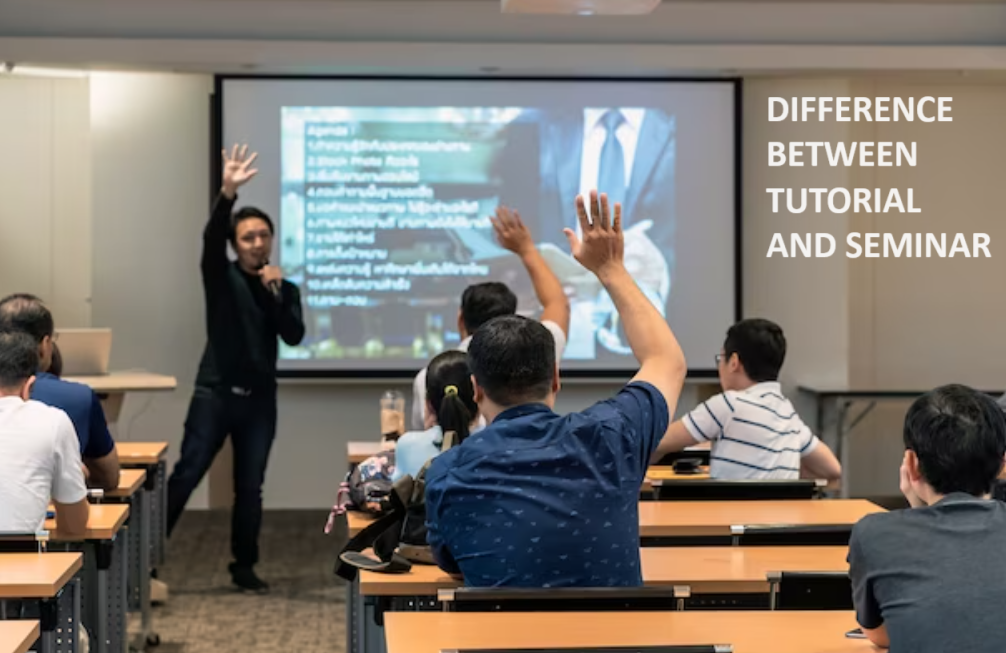Exploring the Differences Between Tutorials and Seminars
There are many different techniques and strategies that may be used in education and learning in order to spread information and promote comprehension. Tutorials and seminars are two often-used techniques. Although these names are sometimes used synonymously, they really have separate meanings and unique qualities.
How-to: Understanding Tutorials
A tutorial is a kind of education where a teacher or instructor gives advice and assistance to a student or group of students, usually one-on-one or in a small group setting. Tutorials are often utilized to support in-class instruction and provide extra support to students who may be having difficulty with a specific topic or idea.
Benefits of Tutorials
Tutorials are often more targeted and individualized, enabling the instructor to adjust the lesson to the individual requirements and learning preferences of the learner. For the student’s benefit, the instructor may provide clarifications, examples, and comments in order to improve understanding. Students may actively participate in and ask questions during highly interactive tutorials.
Advantages of Tutorials
The individualized attention that students get in tutorials is one of their key benefits. They have the chance to clarify things and ask questions about subjects that they find difficult. This individualized method has the potential to significantly improve student learning and assist students in overcoming obstacles.
Lecture: A Look at Seminars
In contrast, a seminar is a more formal and organized assembly of people, often facilitated by a competent or experienced speaker. Seminars are meant to provide a forum for conversation, idea sharing, and information exchange. They are often structured around a particular subject or theme.
The Essence of Seminars
In a seminar, group interaction and communal learning take precedence over one-on-one teaching. Information is presented, thoughts are shared, and attendees are encouraged to participate in thoughtful dialogues by the speaker or facilitator. Presentations, case studies, and group activities are often used at seminars to promote participation.
Table of Differences between Tutorial and Seminar
| Characteristic | Tutorial | Seminar |
|---|---|---|
| Format | Usually small-group or one-on-one sessions | Often larger-group sessions |
| Focus | Emphasis on interactive learning and individualized attention | Emphasis on group discussion and presentation |
| Structure | May follow a structured curriculum or be tailored to individual needs | May have a structured agenda with multiple speakers or presentations |
| Duration | Usually shorter in duration, ranging from minutes to a few hours | Often longer in duration, ranging from hours to days |
| Interaction | Encourages active participation and engagement from all participants | Allows for interaction but may be more focused on listening to speakers |
| Facilitator | May be a tutor, instructor, or expert in the subject matter | May be a speaker, presenter, or panel of experts |
| Learning Style | Supports various learning styles, including visual, auditory, and kinesthetic | May cater more to auditory and verbal learning styles |
| Objective | Often aims to reinforce understanding, clarify concepts, and provide individualized support | May aim to disseminate information, foster discussion, or address specific topics |
| Setting | Can take place in various settings, such as classrooms, labs, or online platforms | Typically conducted in formal settings like conference rooms, auditoriums, or lecture halls |
| Examples | Private tutoring sessions, coding tutorials, language learning tutorials | Research seminars, academic seminars, business seminars |
Key Differences Between Tutorials and Seminars
Although both seminars and tutorials are excellent learning resources, there are a few significant distinctions between the two:
Format
While seminars are attended by a larger number of people, tutorials are usually given one-on-one or in small groups.
Focus
While seminars place more of an emphasis on group interaction and collective learning, tutorials place more of an emphasis on individualized teaching.
Structure
While seminars are facilitated by a speaker or facilitator and have a more set agenda, tutorials are often more adaptable and may be customized to the individual requirements of the students.
Objective
The purpose of a tutorial is to provide students with extra help and support, while the purpose of a seminar is to encourage networking, discussion, and information exchange.
Distinguishing Tutorial and Seminar Formats
A tutorial and a seminar are two different types of teaching that have different goals, formats, and prerequisites.
Comparing Educational Sessions
A tutorial is a more concentrated kind of education meant to help a smaller number of students engage in active learning. Tutorials are interactive discussions that center on a single subject and are shaped by the interest and participation of the students. Prior to the session, the majority of tutorials also call for certain preparation, including reading or studying. Compared to seminars, tutorials are often more regimented and frequently adhere to a custom timetable set by the tutorial presenter.
Understanding Tutorials and Seminars
There are two different types of instructional sessions: tutorials and seminars. In a tutorial, a few students work closely with an instructor or tutor in small groups. With an emphasis on interactive learning, the tutor offers advice and assistance to students so they can comprehend and apply the material. Discussions, problem-solving techniques, and practical exercises are often included in tutorials.
Choosing Between Tutorials and Seminars
Depending on the topic, the students, and the course objectives, both tutorials and seminars may be useful teaching strategies. In general, tutorials work better in big classrooms where students may delve deeply into a specific subject, while seminars work better in larger discussions and idea development. In the end, the course material and the learning preferences of the students should dictate the most appropriate mode of teaching.
Final Thoughts on Tutorials and Seminars
Both seminars and tutorials have benefits of their own and may be useful in various learning environments. The particular requirements and objectives of the students will determine which option is best.
Tutorials place an emphasis on interactive learning in small groups, with tutors assisting students with exercises and conversations. Conversely, seminars are more extensive presentations in which a specialist imparts information and perspectives to a group of people.
Summarizing Tutorials and Seminars
To sum up, tutorials and seminars are two different approaches to teaching and learning. Tutorials provide tailored assistance and direction, while seminars furnish a forum for collective engagement and the exchange of information. Knowing the distinctions between the two may assist instructors and students in selecting the best strategy for a given teaching scenario.



